![]()
![]()
![]()
Use LEFT and RIGHT arrow keys to navigate between flashcards;
Use UP and DOWN arrow keys to flip the card;
H to show hint;
A reads text to speech;
27 Cards in this Set
- Front
- Back
|
Pluripotent
|
small mononuclear cells
-self-perpetuating -forms colonies (CFU) |
|
|
Multipotent
|
can differentiate into lymphoid or myeloid cells
|
|
|
Progenitor cells
|
committed a cell lineage. developmental restriction, allows tremendous amplification
|
|
|
Precursor cells
|
can proliferate into mature cells of various types. Has morph. charac. specific to lineage
|
|
|
Embryo Hematopoiesis
|
wk 3: fetal yolk sac
then, liver 2nd trimester: spleen at term: BM <4yr: all bone cavities adults: axial skeleton, proximal long bone |
|
|
stroma includes:
|
fat cells, macrophages, endothelial cells, fibroblasts
|
|
|
Non-lineage specific Growth Factors (for hematopoiesis)
|
Act on pluripotent & multipotent SC's. initiate self-renewal & differentiation
-IL-3 -GM-CSF |
|
|
Lineage specific Growth Factors (for hematopoiesis)
|
G-CSF
M-CSF IL-5 EPO TPO (thrombopoietin) |
|
|
Erythropoiesis
|
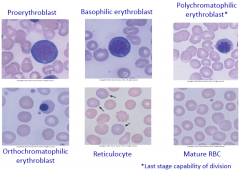
proerythroblast
basophilic erythroblast polychromatophilic erythroblast (last stage capable of division) orthochromatophilic erythroblast reticulocyte mature RBC |
|
|
Proerythroblast (pronormoblast)
|
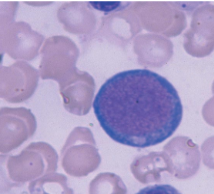
LARGE cells w/ intense blue cytoplasm & round nucleus w/ few NUCLEOLI
-committed stem cell |
|
|
Basophilic Erythroblast (normoblast)
|
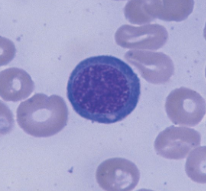
intense darker blue cytoplasm, condensed nuclear chromatin, WITHOUT nucleoli
|
|
|
Polychromatophilic Erythroblast
|
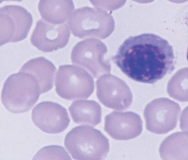
grayish cytoplasm (Hgb production), smaller condensed nucleolus
-last stage capable of division -first cell to make Hgb* |
|
|
Orthochromatophilic Erythroblast
|
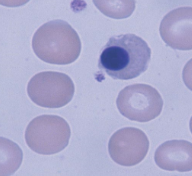
reddish cytoplasm, very small condensed nucleus
|
|
|
Reticulocyte
|
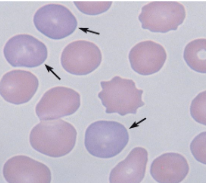
after orthochromic normoblast extrudes nucleus.
retains mitochondria and polyribosomes (Hgb produc) -first immature RBC -remnants of RNA = "reticular" |
|
|
mature RBC
|
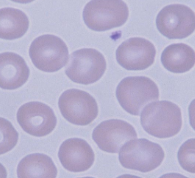
after reticulocyte loses capacity for aerobic metabolism and Hgb synthesis
a couple days after leave BM -120 day lifespan |
|
|
Granulopoiesis
|
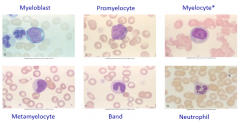
myeloblast
promyeloblast myelocyte metamyelocyte band neutrophil |
|
|
Myeloblast
|
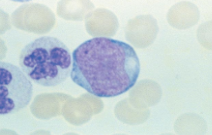
large cell, high N:C ratio
-nucleus: delicate chromatin pattern w/ few nucleoli |
|
|
Promyelocyte
|
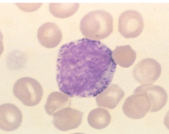
similar to myeloblast appearance, except cytoplasm contains primary (purple) granules
|
|
|
Myelocyte
|
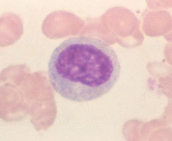
*last stage capable of division.
-nucleus: smaller, condense, lacks nucleoli, may be eccentrically located -cytoplasm: secondary (pink) granules -granules specific to neutrophils/eosinophils/basophils |
|
|
Metamyelocyte
|

kidney-shaped nucleus, pink cytoplasm
|
|
|
Band
|
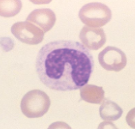
horseshoe nucleus, pink cytoplasm
|
|
|
Neutrophil
|
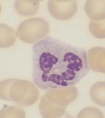
highly condense, loculated nucleus
-first line of defense against microorganisms -lysosomal enzymes digest ingested bacteria |
|
|
Monocytopoiesis
|
monoblasts -> monocytes, leave bloodstream -> part of mononuclear phagocyte system
|
|
|
Megakaryocytopoiesis
|

-megakaryocytes mature into multilobed giant cells (endomitotic divisions)
-cytoplasm becomes granular, released into BM sinusoids in ribbons that contain platelets |
|
|
Lymphopoiesis
|
B-cells: differentiate in BM, then to lymphoid organs
T-cells: differentiate in thymus, then to lymphoid organs |
|
|
nl Adult BM
|

-50% fat cells
-myeloid:erythroid = 2:1 to 7:1 -megakaryocytes: 2-5 per high power field -plasma cells <3% -lymphocytes <20% |
|
|
Cellular Components of Blod
|
-Erythrocytes
-Granulocytes (basophils, neutrophils, eosinophils) -Monocytes -Lymphocytes -Platelets |

